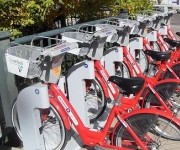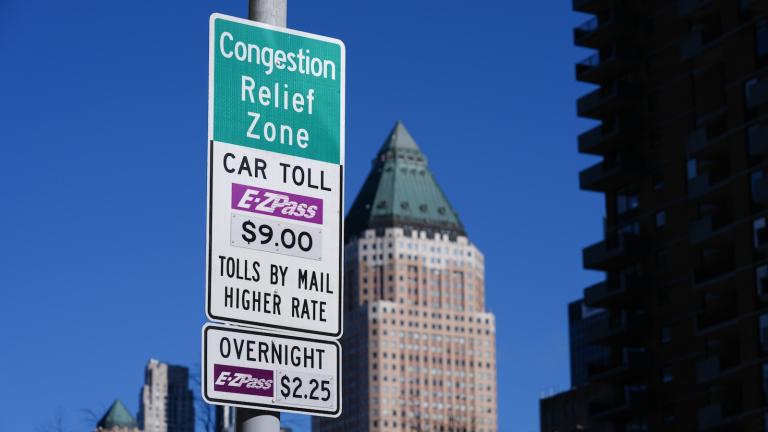Helmet not included.Photo: Paul SwansenCross-posted from Sightline Daily.
Imagine for a moment that cities around the world are rolling out fleets of magic carpets, and that those carpets are having truly wizardly effects: improved public health and safety, reduced traffic congestion and carbon emissions, and reduced dependence on foreign oil. City dwellers can check them out or drop them off at stations everywhere, and they are free to use for up to 30 minutes. After that, they cost something, but not much. Picture literally millions of citizens using these carpets for short, speedy trips all over town. Now imagine being in the Northwest and watching this opportunity fly by because fanatical carpet helmet laws discourage would-be riders.
This is exactly what’s happening. The magic’s not in carpets, though: It’s in the humble bicycle.
Public bike-share programs, whether run by municipal governments, private entities, or both, are built on a simple idea: blanket urban areas with hundreds, even thousands, of identical, sturdy bikes, and give people a huge network of convenient stations at which to park them. Make the system accessible and reliable, so that city dwellers can get to nearby destinations, on time and without a hassle. Don’t worry about theft and payment systems, either: bike sharing has come a long way since Amsterdam’s unsuccessful attempt in the 1960s. The latest systems tie checkouts to credit and debit cards, significantly deterring theft, and fees are kept quite reasonable through subsidies from advertising on stations and on the bikes themselves. In Dublin, a three day pass is only $3, while a year’s subscription to the network costs just $15!
Cities everywhere are climbing aboard. Check out these videos from London, D.C., and especially Hangzhou, China (watch it below). Hangzhou’s enormous bike-sharing program of 50,000 bikes and 2,050 stations has already become an integral component of the city’s transit network. The program is so popular the city plans to expand its fleet to 175,000 bikes by 2020.
Public bikes in places like Hangzhou are a normal, safe part of the urban scene, and people don’t think twice about swiping a card or inserting a membership key to get a quick ride any time of the day. Dozens, even hundreds, of bike-share programs have popped up across the world, as the Institute for Transportation & Development Policy has documented [PDF]. Almost every one of them launched in the last decade. To see just how many there are, look at this map of bike-share programs.
Click the map for a larger view.
If bike sharing has been successful in so many places, why isn’t the Pacific Northwest already in on this? Why are there only two operational bike-sharing programs in all of Cascadia — a small one in Pullman, Washington, on the campus of Washington State University, and a tiny one in Golden, British Columbia? Golden has 15 bikes, which mostly go back and forth between the town center and a nearby campground. It turns out there’s something the Northwest has that other places do not, and it makes all the difference: mandatory helmet laws. British Columbia’s helmet law is provincewide. Numerous cities and counties in Washington, including King County and Spokane, have helmet laws. In Oregon, only riders under 16 are required to wear helmets, but until now, cities such as Portland have been slow to set aside money for bike sharing because the competition for scarce funding is fierce.
There is nothing more contentious in the cycling community than the debate over helmets, and though the safety research is mixed, the political lines are sharply drawn. When it comes to bike sharing, however, there are a few things on which the evidence is clear:
- Bike sharing attracts first-time cyclists … As the links above show, the typical users of public bikes are not die-hard or even regular cyclists. They’re newbies who see a convenient way to get from one place to another and hop on.
- … who make things safer … Just as drivers are more careful at crosswalks in pedestrian-packed downtowns, they are more aware and cautious of cyclists when the streets are full of them. Adding new cyclists to streets makes the environment dramatically safer for everyone.
- … but only if helmets are optional. The only failed program in the world is Melbourne’s. It’s also the only one put in place under a helmet law. As this short video documents, Dublin has launched a program of similar scope (450 bikes versus Melbourne’s 600), but its fleet clocks 5,000 trips per day, while Melbourne’s barely manages 70. Dublin’s program has already racked up a million trips without a single fatality, and a stunning 40 percent of users are first-time cyclists.
Forcing casual riders to don helmets is a high barrier to bike sharing. It depresses ridership, getting in the way of the overwhelming health and safety benefit of having more bikes on the roads. Providing headwear at kiosks or local businesses raises concerns about sanitation (lice!) and safety (cracked helmets). Casual, would-be riders weigh those concerns and decide to keep walking.
Besides, no bike-sharing program tells people not to wear helmets. They just leave wearing one as a personal choice.
The crux of the matter is this: The Pacific Northwest can reap the huge benefits of bike sharing without compromising safety. It just needs to tweak its helmet laws. Here are two ways to do it:
- Make riding helmetless a secondary offense. Adjusting the law so cyclists cannot be cited unless they do something else illegal would allow people to take safety decisions into their own hands. Helmets are often compared to seat b
elts, so why not give them the same legal status? - Make an exemption for bike-share users. Pedicabs (three-wheeled rickshaws for hire) are excluded from helmet laws, both for drivers and passengers, and their safety records are stellar. Vancouver’s bike share feasibility study [PDF, see page 56] found that in the 12 years since the pedicab helmet exemption took effect, there has not been one reported head injury. There are also exemptions for people with religious objections (it’s hard to put a helmet over a turban), children on tricycles, and even people with big heads. Why not public bikes?
Though our helmet fiats are the greatest legal obstacle to a bike share rollout, there are a couple other barriers worth mentioning. A recent University of Washington study [PDF] examined the feasibility of bike-sharing in Seattle and discovered a slew of hurdles over curb-space usage and the city’s sign rules. Bike-share programs sell advertising space on their bike stations to help cover their costs, so the design of the bike stations must reflect the needs of advertisers. At a minimum, that means that having consistent and easily understood sign rules is a must. In Seattle, though, almost every district from Pioneer Square to Ballard has its own sign guidelines. This patchwork of regulations makes it hard to design a single, modular bike-share station that will be legal citywide. And custom bike stations would be prohibitively expensive.
Fortunately, Seattle’s municipal code allows the director of the Department of Planning and Development to issue signage exemptions in downtown areas. No doubt other Northwest cities have their own particular hoops to jump through, but once the helmet barrier is addressed, nothing should truly stand in the way of a concerted push to bring this transportation revolution to Cascadia.
Bike sharing is too good an opportunity to let pass. It’s sustainable, healthy, and doesn’t require extra parking garages or oil imports. Fortunately, Vancouver has solicited contractor bids to design a system in spite of BC’s helmet law, and Seattle and Portland are exploring the idea. Let’s treat bike-share riders like pedicab passengers, exempt them from helmet rules, and join the global wave of magic carpet rides.


